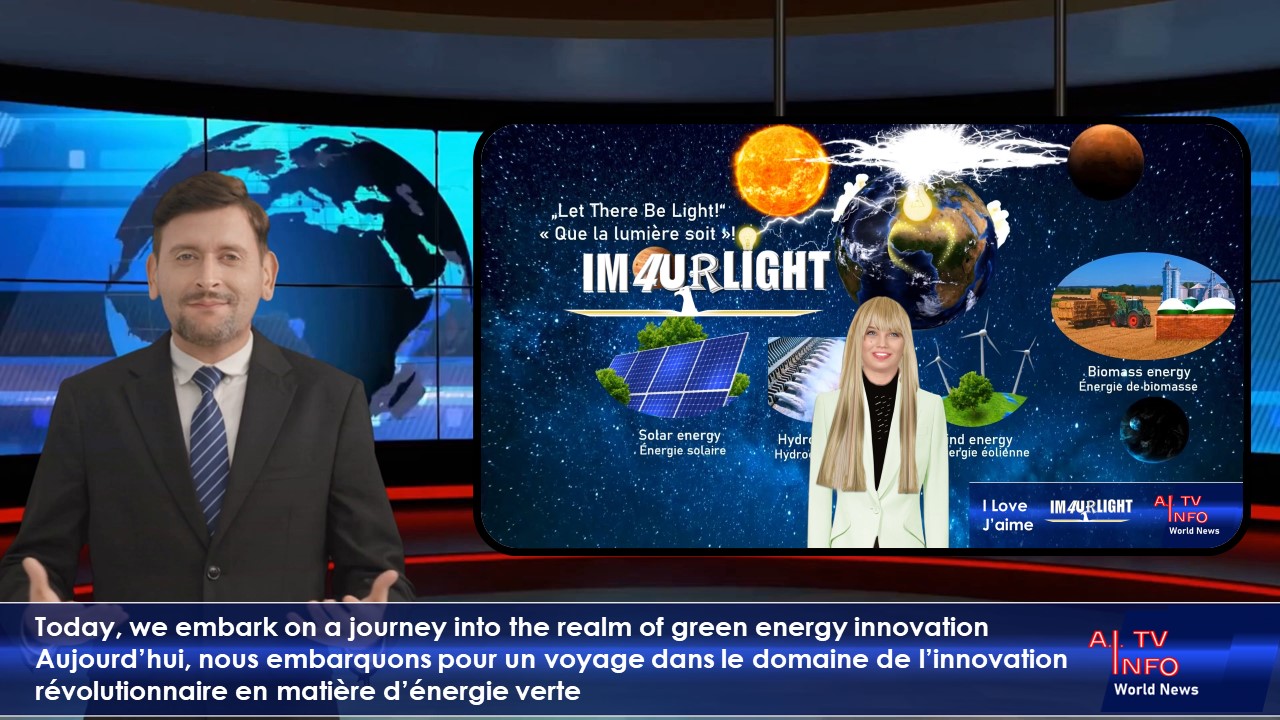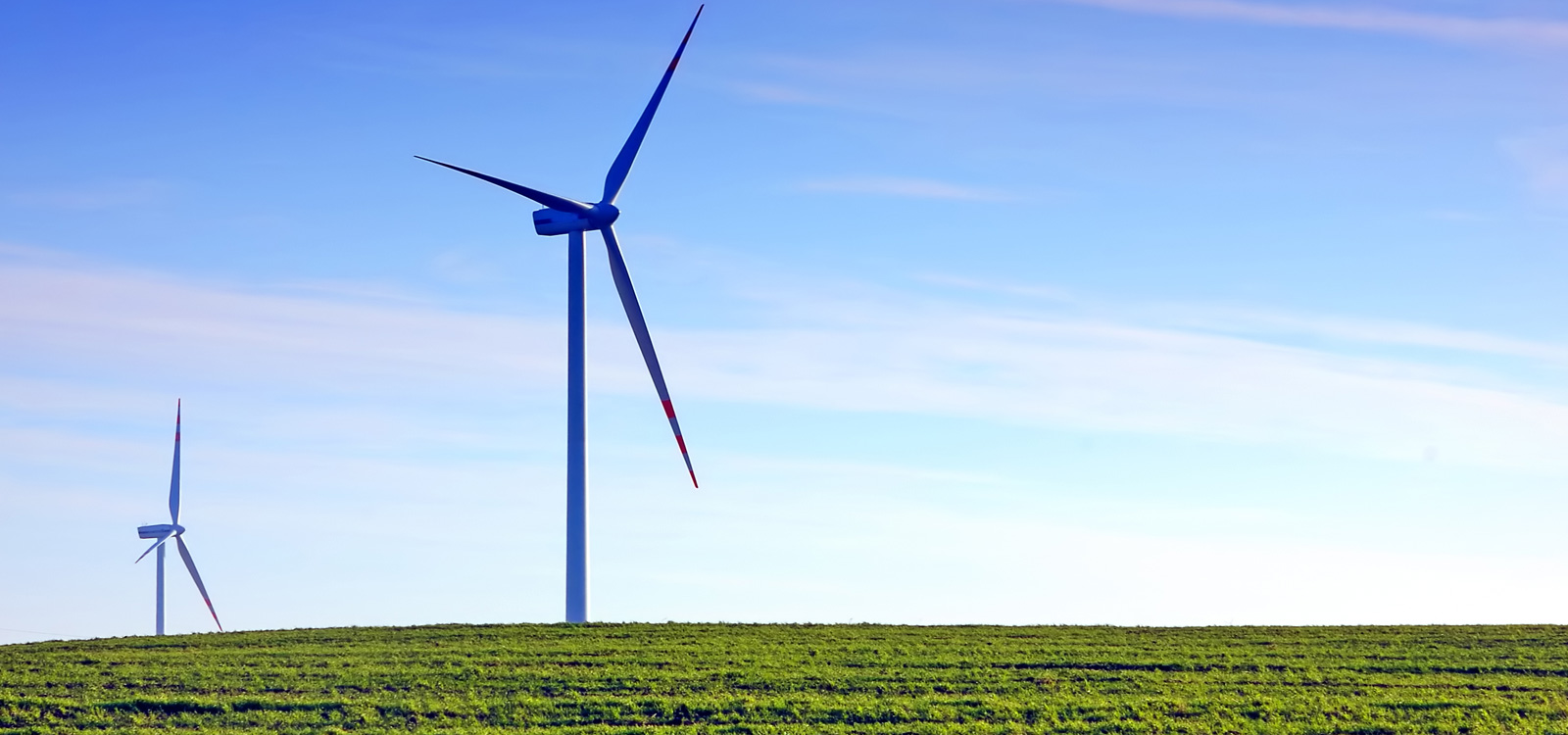Hydropower, or hydroelectric power, is one of the oldest and largest sources of renewable energy, which uses the natural flow of moving water to generate electricity. Hydropower currently accounts for 31.5% of total U.S. renewable electricity generation and about 6.3% of total U.S. electricity generation.
While most people might associate the energy source with the Hoover Dam—a huge facility harnessing the power of an entire river behind its wall—hydropower facilities come in all sizes. Some may be very large, but they can be tiny, too, taking advantage of water flows in municipal water facilities or irrigation ditches. They can even be “damless,” with diversions or run-of-river facilities that channel part of a stream through a powerhouse before the water rejoins the main river. Whatever the method, hydropower is much easier to obtain and more widely used than most people realize. In fact, all but two states (Delaware and Mississippi) use hydropower for electricity, some more than others. For example, in 2020 about 66% of the state of Washington’s electricity came from hydropower.
HOW DOES HYDROPOWER WORK?
Hydropower technologies generate power by using the elevation difference, created by a dam or diversion structure, of water flowing in on one side and out, far below, on the other. The Department of Energy’s “Hydropower 101” video explains how hydropower works and highlights some of the research and development efforts of the Water Power Technologies Office (WPTO) in this area.
WHAT IS THE COST OF HYDROPOWER?
Hydropower is an affordable source of electricity that costs less than most. Since hydropower relies only on the energy from moving water, states that get the majority of their electricity from hydropower, like Idaho, Washington, and Oregon, have lower energy bills than the rest of the country.
Compared to other electricity sources, hydropower also has relatively low costs throughout the duration of a full project lifetime in terms of maintenance, operations, and fuel. Like any major energy source, significant upfront costs are unavoidable, but hydropower’s longer lifespan spreads these costs out over time. Additionally, the equipment used at hydropower facilities often operates for longer periods of time without needing replacements or repairs, saving money in the long term.
The installation costs for large hydropower facilities consist mostly of civil construction works (such as the building of the dams, tunnels, and other necessary infrastructure) and electromechanical equipment costs (electricity-generating machinery). Since hydropower is a site-specific technology, these costs can be minimized at the planning stage through proper selection of location and design.
WHAT ARE THE BENEFITS OF HYDROPOWER?
The benefits of hydropower have been recognized and harnessed for thousands of years. In addition to being a clean and cost-effective form of energy, hydropower plants can provide power to the grid immediately, serving as a flexible and reliable form of backup power during major electricity outages or disruptions. Hydropower also produces a number of benefits outside of electricity generation, such as flood control, irrigation support, and water supply.
WHAT IS THE HISTORY OF HYDROPOWER?
The history of hydropower dates back thousands of years. For example, the Greeks used water wheels to grind wheat into flour more than 2,000 years ago. The evolution of the modern hydropower turbine began in the mid-1700s when a French hydraulic and military engineer, Bernard Forest de Bélidor, wrote Architecture Hydraulique. Many key developments in hydropower technology occurred during the first half of the 19th century, and more recently, the past century has seen a number of hydroelectric advancements that have helped hydropower become an integral part of the renewable energy mix in the United States.
To learn how to join the hydropower industry and more about science, technology, engineering, and mathematics (STEM) workforce development opportunities, visit the Hydropower STEM Portal.
Scientists determined that by increasing the accuracy of weather forecasts over the last decade, consumers netted at least $384 million in energy savings. The researchers based their predictions on NOAA’s High Resolution Rapid Refresh model, which provides daily weather forecasts for every part of the U.S. These include wind speed and direction data, which utilities can use to gauge how much energy their turbines will produce.
Achieving geopolitical stability and global energy security shared the limelight this week as top business and government leaders made their annual trek to Davos, Switzerland.
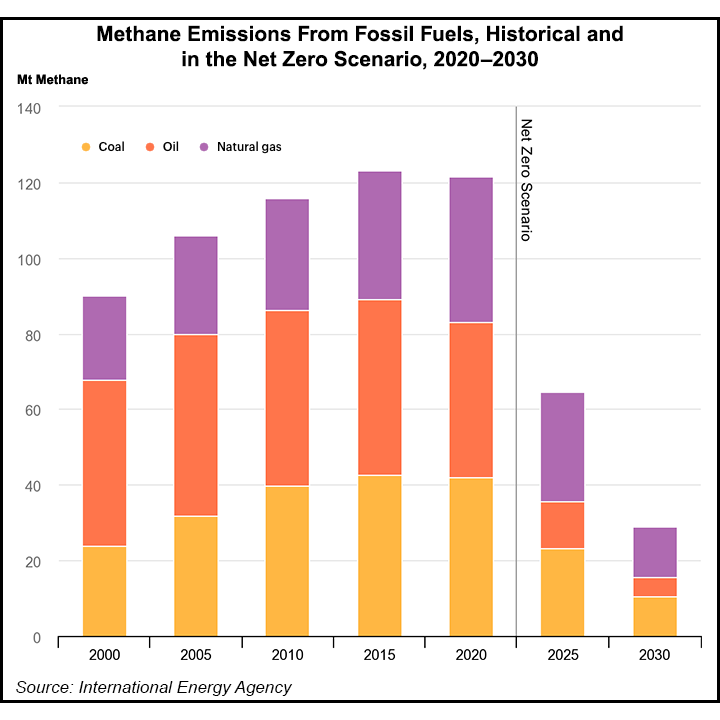
The annual meeting of the World Economic Forum (WEF) addressed worldwide inequity and the chances for a recession. However, several sessions focused on two points: Russia’s invasion of Ukraine, intertwined with a call to sharply reduce global greenhouse gas emissions.
Occidental Petroleum Corp. CEO Vicki Hollub shared a panel discussion about energy security with PG&E Corp. CEO Patricia K. Poppe, International Energy Agency (IEA) executive director Fatih Birol and the Czech Republic’s Jozef Sikela, minister of Industry and Trade.
The world has “never, ever seen an energy crisis of this depth and complexity” following the invasion last February by Russia into Ukraine, Birol said.
However, the global energy emergency has ushered in a “big boost” for renewable energy. That in turn lifts energy security, Birol said.
For example, the IEA chief said the U.S. Inflation Reduction Act (IRA), signed into law by President Biden last year, was hailed as the “most important climate action” since the 2015 United Nations (UN) climate accord.
IRA directs billions toward climate and energy policies. It is designed to invest in infrastructure that in part would put the country on track toward net-zero emissions by 2050.
Hollub, who has praised the IRA previously, also called the legislation key to helping move toward lower emissions. “It’s an important bill for us, in that it does provide subsidies, not just for carbon capture but for electric vehicles, for lithium and for many other things that will help the energy transition.”
The U.S. oil and natural gas industry has long relied on subsidies, Hollub noted.
“There has been hardly any game-changing and transformational technologies that have ever been developed in the world that did not at some point have some sort of subsidy,” she said.
Money, Money, Money, Etc.
Separately, the Biden administration’s climate envoy John Kerry, who shared a dialogue on another panel at Davos, said financing a global transition to a low carbon economy could avoid damage caused by climate change.
“How do we get there?” Kerry asked the audience. “The lesson I have learned in the last few years…is money, money, money, money, money, money, money.” Investments could help meet a UN goal to limit global warming to 1.5 degrees C above pre-industrial levels.
Geopolitical stability is “absolutely key” to ensuring energy security, Saudi Arabia’s Foreign Minister Faisal bin Farhan Al Saud said on another panel. The foreign minister noted that Saudi Arabia is “investing almost $200 billion in renewable energy at home and abroad” as it brings online more low-carbon technologies.
Saudi’s ambitions toward a low-carbon economy are big, as the country is one of the top oil producers in the world. Al Saud noted that Saudi companies “are active in 21 countries, deploying solar and wind energy and other sorts of renewable energy. In the meantime, we need to maintain a supply of traditional energies that are priced in a way that ensures stability. And we will continue to address this in a responsible way.”
Davos brought together top leaders to share concerns and set priorities because of myriad geoeconomic challenges, speakers said.
“This meeting is happening against one of the most complicated geopolitical and geoeconomic landscapes that we have seen for decades, and this session is about identifying opportunities for cooperation even in a fractured world,” WEF President Børge Brende said.
‘Category Five Hurricane’
UN Secretary-General António Guterres on Wednesday in Davos said, “Our world is plagued by a perfect storm on a number of fronts.” He called for urgent action on the interconnected challenges. And he took a swipe at the oil and gas industry, calling for an end to the “addition to fossil fuels” and to “stop our self-defeating war on nature.”
Said Guterres, “We can’t confront problems unless we look them squarely in the eye. And we are looking into the eye of a Category 5 hurricane. Our world is plagued by a perfect storm on a number of fronts.”
There also is an “existential challenge,” he said, as the world is “flirting with climate disaster…Greenhouse gas emissions are at record levels. The commitment to limit global temperature rise to 1.5 degrees is going up in smoke. Without further action, we are headed to a 2.8 degree increase.”
Guterres told the audience that the developed nations “must finally deliver on its $100 billion climate finance commitment to support developing countries. Adaptation finance must be doubled. And the biggest emitters,” the Group of 20 developed nations, “must unite around a Climate Solidarity Pact in which they make extra efforts in the 2020s to keep the 1.5 degree limit alive.”
The UK parliament has released a research briefing analysing the country’s current position on, and outlook for, the use of biomass.
It stated that the Climate Change Committee (CCC) expects demand for biomass in the UK to rise significantly in the coming decades, as a means to supply bioenergy with carbon capture and storage (BECCS).
It also expects demand to increase from other industries requiring biomass, such as aviation in fuels. Meeting this increased demand will require an expansion in domestic production to avoid increasing imports, the report found, and sufficient land will be required for cultivation.
Whilst dedicated energy crops have the potential to make a strong contribution to domestic biomass supply, the expansion of UK biomass production encounters social, economic and technical challenges. According to the report, stakeholders have said that current policy frameworks fail to provide sufficient long-term certainty to provide confidence for potential energy crop growers.
The government’s upcoming Biomass Strategy will discuss how biomass use can best contribute towards net zero across multiple economic sectors. Originally scheduled to be published in 2022, it is now expected this year, the report said.
Bioenergy is currently the second largest source of renewable energy in the UK, generating 12.9% of the total UK electricity supply in 2021. Bioenergy could deliver negative emissions when combined with BECCS, assisting the UK in achieving its legal commitment to reaching net-zero carbon emissions by 2050.
The expansion of BECCS would require additional CCS infrastructure and the sufficient supply of biomass feedstocks. Presently, approximately one third of UK biomass feedstocks are imported. Wood pellets from North America are the country’s dominant feedstock for use in electricity in generation.
The report added that non-governmental organisations (NGOs) and the European Academies’ Science Advisory Council (EASAC) have raised sustainability concerns about biomass imports. The UK could face increasing competition for biomass as global demand rises. The CCC recommended dedicated energy crops and forest residues as future sources of domestic biomass, although it is acknowledged that imports will continue to play a role.
- Amazon, Facebook parent company Meta and Google, owned by parent company Alphabet, are the top three corporate purchasers of wind and solar energy, according to a report published Wednesday from the American Clean Power Association, an industry group.
- In total, 326 companies contracted 77.4 gigawatts of wind and solar energy by the end of 2022, which is enough energy to power over a thousand data centers or 18 million American homes.
- Texas is benefitting more than any other state. Companies have bought clean energy from 540 projects located in 49 states, Washington DC and Puerto Rico, but 35% of contracted capacity bought by companies is coming from Texas, the report finds.
Technology companies are leading the charge of companies buying wind and solar power.
Amazon, Facebook parent company Meta, and Google, owned by parent company Alphabet, are the top three corporate purchasers of wind and solar energy, according to a report published Wednesday from the American Clean Power Association, an industry group.
Amazon had contracted 12.4 gigawatts of clean wind and solar energy in the United States through September 2022, while Meta had contracted 8.7 gigawatts and Google had contracted 6.2 gigawatts, according to the report.
These procurement totals are since the first time these companies have announced they were buying wind and solar power last decade.
The technology sector is certainly outpacing other industries in buying clean power, but it’s been increasing across all industries. From 2012 to 2022, the amount of wind and solar energy bought by companies has increased by an average of 73 percent per year. It passed 1 gigawatt in 2015, 8 gigawatts in 2018, and nearly 20 gigawatts last year.
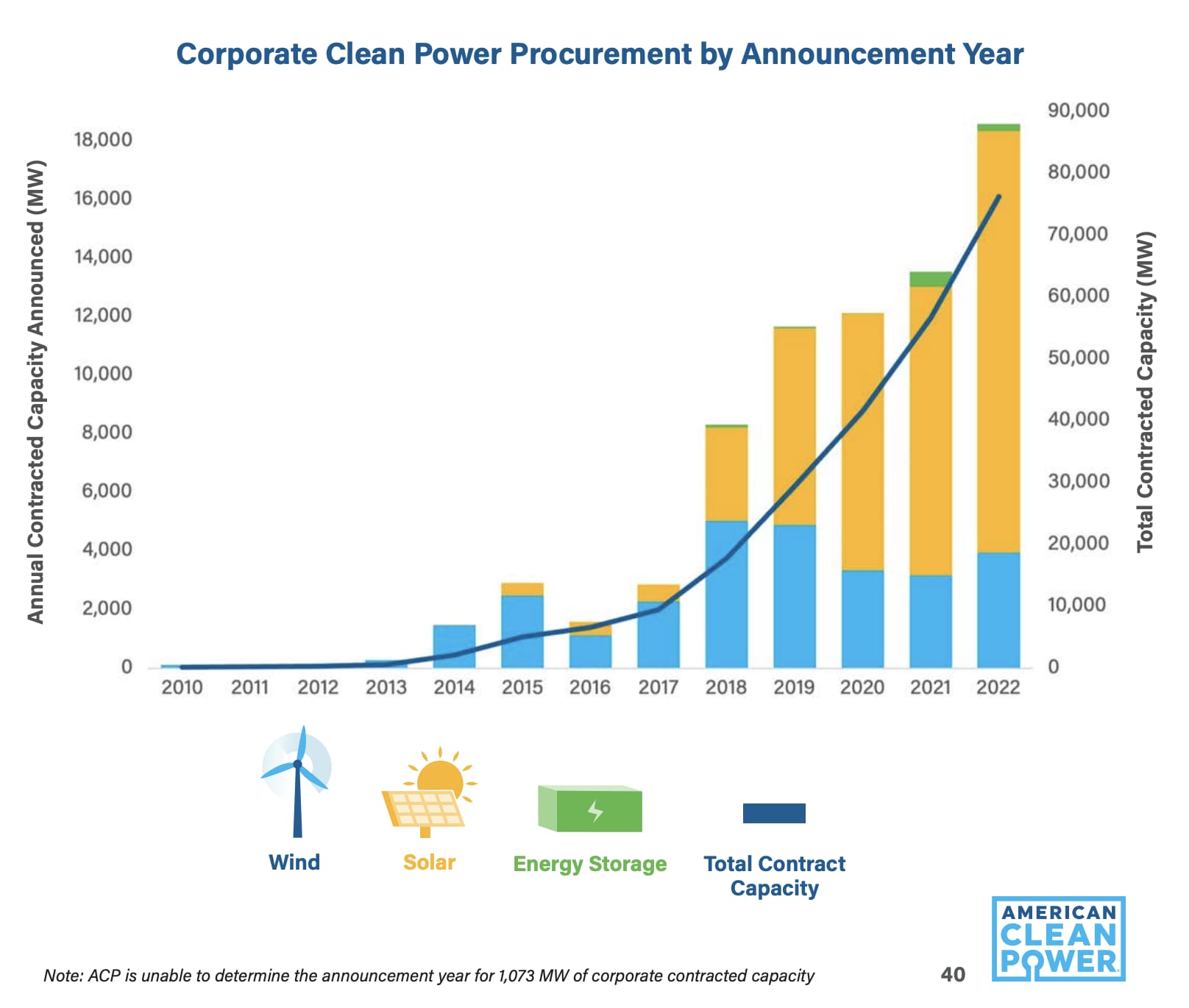
Wind and solar power procured by companies by year, according to the American Clean Power Association, an industry group.
American Clean Power Association
The switch is not just driven by a desire to save the world from climate change. The price of clean power has been falling steadily. In the past decade, the cost has fallen 71 percent and 47 percent, respectively, according to the report.
The technology sector is the clear leader when it comes to buying clean energy, and has contracted 48 percent of all wind and solar power. The energy, telecommunications and food and beverage sectors are the next largest corporate buyers and have contracted 9, 8 and 7 percent of total contracted wind and solar, respectively.
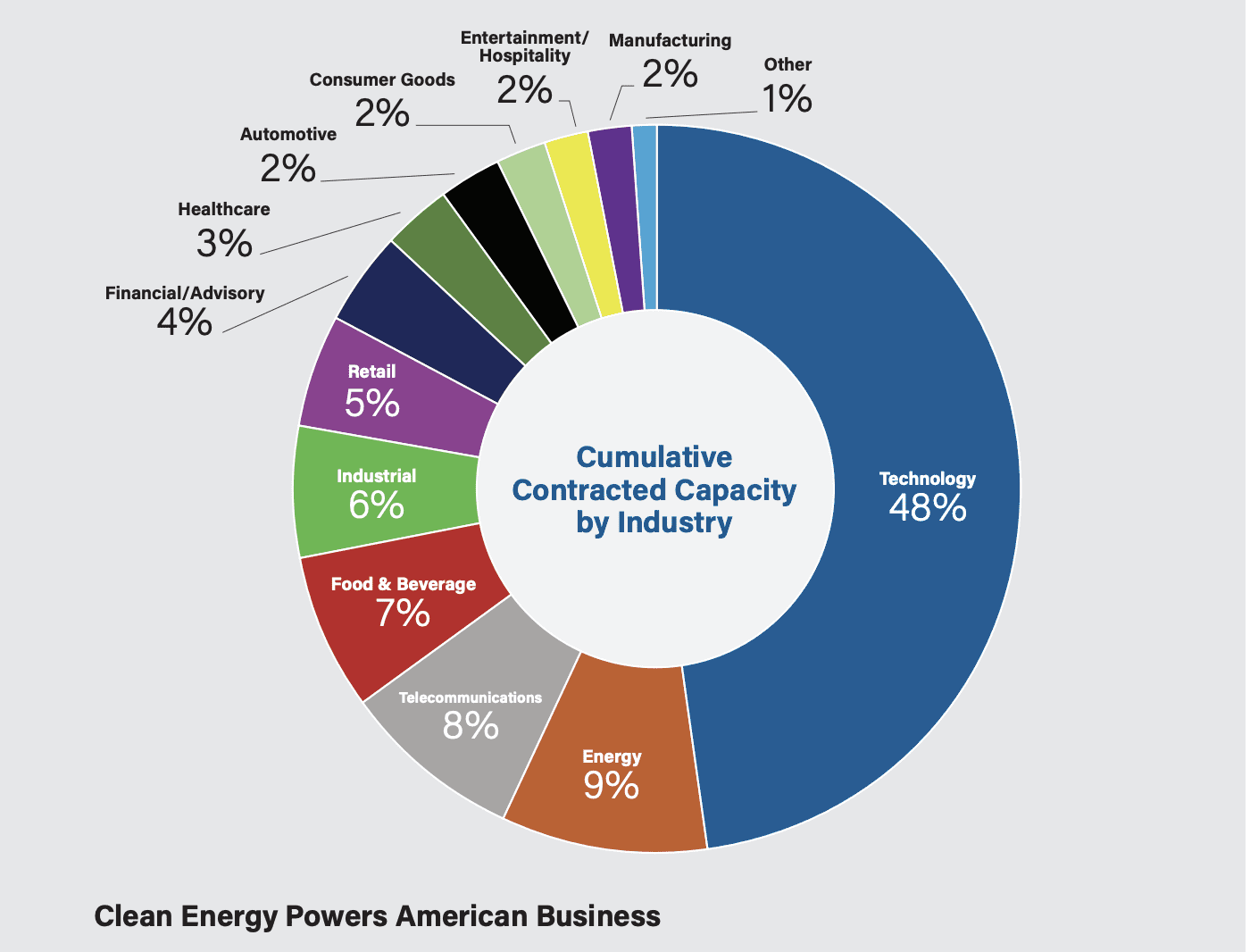
Total contracted wind and solar power by industry, according to the American Clean Power Association, an industry group.
American Clean Power Association
In total, 326 companies contracted 77.4 gigawatts of wind and solar energy by the end of 2022, which is enough energy to power over a thousand data centers or 18 million American homes.
Of that 77 plus gigawatts of wind and solar power that has been contracted, 36 gigawatts or 47 percent is currently operating, meaning more than half still is still in development. The time it takes to go from a company buying wind or solar power and the project being online depends, but most of the procured projects are expected to come online in the next three years, a spokesperson for American Clean Power told CNBC.
Companies represent a significant piece of the total wind and solar landscape: 16 percent of wind and solar energy was headed towards corporations by the end of 2022. The remaining 84 percent goes to other energy purchasers, like utility companies.
As companies increase their purchasing of wind and solar power, Texas is benefitting more than any other state. Companies have bought clean energy from 540 projects located in 49 states, Washington DC and Puerto Rico, but 35% of contracted capacity bought by companies is coming from Texas, the report finds.
UN Climate Change News, 18 January 2023 – The uptake of renewable energy is moving faster and further than projected but radical action is still needed to accelerate the energy transition.
Speaking at the International Renewable Energy Agency (IRENA) Assembly in Abu Dhabi last weekend, Stiell said the positive outcomes from last November’s UN Climate Change Conference COP27 give the world enormous opportunity to make progress, starting now.
“It requires the cooperation of every single country represented in this room,” said Stiell. “All Parties must come together in order to achieve the level of ambition needed to get to where we need to go, and we have a lot of work to do to get there.”
There is reason for optimism when it comes to renewable energy because renewables are moving further and faster than projected. Here are just a few examples:
- Renewable electricity capacity additions have been outpacing those of non-renewables since 2014.
- The International Energy Agency’s (IEA) Renewables Outlook complements this, noting that renewables are set to account for over 90% of global electricity capacity expansion in the next five years and that renewables will become the largest source of global electricity generation by early 2025, surpassing coal.
- In Europe alone, the IEA estimates that the continent’s renewable electricity expansion will double over the 2022-2027 period as energy security concerns add to climate ambitions.
- Worldwide renewable energy employment reached 12.7 million last year, a jump of 700,000 new jobs in one year. Solar energy was found to be the fastest-growing sector. In 2021 it provided 4.3 million jobs, more than a third of the current global renewable workforce.
But there is also reason for frustration. As IRENA pointed out in its submission to the global stocktake, regardless of increased ambition expressed by countries at the last two COPs, current climate pledges and overall finance to support the shift to renewables remains insufficient.
The COP27 cover decision recognized that: “about USD 4 trillion per year needs to be invested in renewable energy up until 2030 to be able to reach net zero emissions by 2050.”
Stiell pointed to the global stocktake as a pivotal process in 2023 where nations and stakeholders can strengthen their climate plans, and translate that into immediate action with specific policies during the next eight years.
The first stocktake will conclude at COP28 and will help the world assess progress towards achieving the Paris Agreement’s goals, including the goal to limit global warming to 1.5C. Countries and stakeholders will see where they’re collectively making progress — and where they’re not.
“This will be a moment of truth both for the process that we are so engaged in but also a moment of truth for the world,” said Stiell. “And two critical questions are going to be asked, and that is: are we measuring up and are we ratcheting up.”
We generally know how global efforts are measuring up. Global emissions need to be nearly halved by 2030 for the world to stand a chance of achieving the Paris Agreement’s goal to limit global temperature rise to 1.5 degrees Celsius. Transformational adaptation is also needed to help communities cope with already occurring climate impacts.
In contrast, the latest UN Climate Change report shows that while countries are bending the curve of global greenhouse gas emissions downward, the combined climate pledges of 193 Parties under the Paris Agreement could put the world on track for around 2.5 degrees Celsius of warming by the end of the century.
Ratcheting up is about how every sector and every government throughout the world will use outputs of the stocktake to do more than just inform and update their climate action.
“The global stocktake will be that moment where we set out a roadmap, a blueprint if you like, for action to get us to where we need to be and will enable us to look at every sector, every region, to give political and technical direction,” said Stiell.
He added that what’s needed from the conclusion of the stocktake are specific policies, prescriptions and interventions that serve to correct the course.
“In order for us to generate the momentum that is required, we need concrete plans to come out of this,” said Stiell. “And this will be our greatest challenge throughout the course of this year if we are to land a robust and meaningful global stocktake at the end of this year.”




